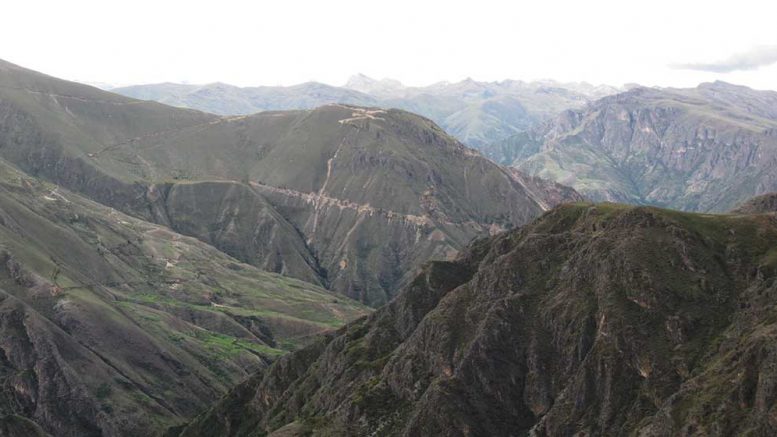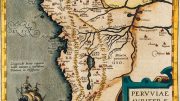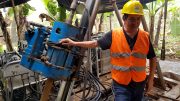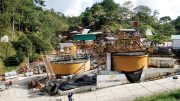Despite centuries of local mining history, the northern Andes remain under-explored by modern standards, and the region stands as one of the favourite destinations of the world’s mineral explorers. Here is a look at eight Canadian-based juniors active in Colombia, Ecuador and Peru.
LUPAKA GOLD
Vancouver-based Lupaka Gold (TSXV: LPK; US-OTC: LPKGF) says its priority is advancing to production its Invicta gold-copper polymetallic project in Peru’s Huaura province, 120 km from Lima.
In all zones at Invicta, there are indicated resources totalling 3 million tonnes grading 4.07 grams gold per tonne, 24.81 grams silver per tonne, 0.60% copper, 0.36% lead and 0.42% zinc for a 558,000 contained oz. gold equivalent. There are another 577,000 inferred tonnes at 4.91 grams gold, 5.49 grams silver, 0.10% copper, 0.11% lead and 0.15% zinc. These figures are at a cut-off grade of 3 grams gold-equivalent per tonne.
A preliminary economic assessment on only part of the Invicta resource envisages an initial mining rate of 350 tonnes per day over a six-year mine life, resulting in annual pre-tax cash flow of US$10.2 million. Lupaka says that by using existing infrastructure, the project “requires very little upfront capital and illustrates a payback of less than one year.”
On March 4, Lupaka reported that “discussions between community leaders and the authorities have resulted in the end of the illegal demonstration” at Invicta, and that, “as previously announced on Oct. 25, 2018, access to Invicta had been restricted due to a blockade by members from the nearby community of Paran. The company has agreed to enter into a formal dialogue with Paran to re-establish a positive working relationship with the community.”
On March 7, Lupaka said it had enhanced its short-term liquidity by a combined $2 million, thanks to a debt-for-share arrangement and a private placement.
Lupaka president and CEO Will Ansley said the liquidity injection is a “significant milestone and development for Lupaka.”
SIERRA METALS
Based in Toronto, Sierra Metals (TSX: SMT; NYSE-AM: SMTS) owns and operates three precious and base metal mines in Latin America: the 82%-owned Yauricocha mine in Peru and the Bolivar and Cusi mines in Mexico.
Located in Lima Department, the Yauricocha mine produces silver, lead, zinc, copper and gold from a high-temperature, carbonate-replacement deposit. It’s an underground mine, with miners using sublevel caving and cut-and-fill methods, as well as ore processing in a flotation plant.
In Mexico, Bolivar produces copper, silver and gold while the smaller Cusi produces silver, lead, gold and zinc. Both are underground mines.
In early March, Sierra entered into a six-year, senior-secured corporate credit facility with Banco de Credito del Peru for funding of up to US$100 million. The company says the arrangement provides it with more liquidity and “financial flexibility to fund future capital projects in Mexico” as well as corporate working capital requirements. The company will also use the proceeds to repay existing debt in the near-term.
In 2018, on a consolidated basis, Sierra Metals produced 2.7 million oz. silver (a 17% increase from 2017), 34.0 million lb. copper (27% increase), 76.8 million lb. zinc (1% increase), 27.7 million lb. lead (7% decrease) and 7,743 oz. gold (25% increase). Full-year financial results are to be released at the end of March.
CONTINENTAL GOLD
Toronto-based, Ari-Sussman-led Continental Gold (TSX: CNL; US-OTC: CGOOF) says its “first-mover advantage” in Colombia has helped it accumulate a portfolio of “high-grade and high-impact exploration and development properties.”
Its wholly owned Buritica gold mine project will soon tap into reserves of 13.7 million tonnes grading 8.4 grams gold per tonne, or 3.7 million oz. gold, with production scheduled for 2020.

Continental Gold’s Buritica gold project in Colombia. Photo by David Perri.
Gold major Newmont Mining owns 19.9% of Continental Gold, after investing US$109 million at a 46% premium to the market (at the time) to help fund project construction.
Continental says it is on schedule with activities at Buritica, where it had planned 100,000 metres of drilling in 2018.
In a March 5 release, Sussman said: “It is a very exciting time for Continental Gold, as we are now drifting along high-grade mineralization in both the Yaragua and Veta Sur systems that we plan to mine by longitudinal long-hole stoping, beginning in 2020. With underground development remaining well ahead of schedule, we are confident that extra time available for pre-production stope preparation will provide the company with a buffer of excess material to feed the plant on planned start-up of commercial production next year.”
PAN ANDEAN MINERALS
Vancouver-based explorer Pan Andean Minerals (TSXV: PAD; US-OTC: BCGOF) has been listed on the TSX Venture Exchange for 11 years, with a focus on copper and gold exploration.
The company says it “acquires prospective gold and copper-gold exploration properties considered to have significant mineral potential by staking, option or purchase agreements” on a portfolio of properties in Peru and Yukon, with the focus being Peru.
However, on March 5, the company said it is “pursuing alternative business opportunities.”
Pan Andean is led by president and CEO Sung Bum “Spencer” Huh, and recently added to its advisory board South Korean business executive Ki-Tae “Robert” Lee, who recently retired as executive officer at Hanwha Investment & Securities after stints as a fund manager, trader and air force pilot.
“Mr. Lee’s wealth of expertise and experience provides the company with an incredible opportunity to access the South Korean capital markets,” CEO Huh said in a release. “I look forward to working closely with Mr. Lee as we explore opportunities in Korea and elsewhere.”
PANORO MINERALS
Vancouver-based, Luquman Shaheen-led Panoro Minerals (TSXV: PML; US-OTC: POROF) continues to advance its flagship Cotabambas copper project in southern Peru, where it has drilled more than 80,000 metres since 2007.
Indicated resources at Cotabambas stand at 117.1 million tonnes grading 0.42% copper, 0.23 gram gold per tonne and 2.74 grams silver per tonne, while inferred resources are 605 million tonnes at 0.31% copper, 0.17 gram gold and 2.33 grams silver.
Panoro also has its large, development-stage Antilla copper-molybdenum project in Peru. Both projects are in the Andahuaylas-Yauri mineral-rich belt.
Panoro says it is “well financed to grow and enhance its two key projects over the next 24 months, including strategic arrangements with Wheaton Precious Metals and Hudbay Minerals,” and that its Peruvian projects could become the “backbone of a new copper-producing company, based in the fastest-growing copper-producing nation in the world.”
In January 2019, Panoro had $21.6 million in funding for ongoing work, and a $66-million market capitalization.
RIO2
From its Vancouver base, Rio2 (TSXV: RIO; US-OTC: RIOFF) says it is “building a multi-asset, multi-jurisdiction, precious metals company focused in the Americas,” with current projects in Peru, Chile and Nicaragua.
In February, Rio2 has closed the first tranche of its non-brokered private placement by issuing 12.6 million units at 46¢ apiece for gross proceeds of $5.81 million. Each unit consists of a share and a warrant, with each warrant entitling the holder to buy another share for 65¢ per share within two years.
In Peru in 2017, Rio2 entered into an option agreement with Compania Minera Milpo, whereby the junior has an option to acquire all rights and interests in seven Milpo gold exploration prospects totalling 190 sq. km in Peru.
In Chile’s Atacama III Region in July 2018, Rio2 acquired a 100% interest in the Fenix gold project by merging with Atacama Pacific Gold Corporation.
In January, Rio2 released encouraging initial results from a new exploration program at Fenix, including highlights from the first 11 reverse-circulation drill holes and four trenches. The drilling represents 2,236 metres of a 7,000-metre drilling program that got underway in November 2018.
TOACHI MINING
Toronto-based junior Toachi Mining (TSXV: TIM; US-OTC: TIMGF) describes its La Plata property in north-central Ecuador as hosting a gold-rich, volcanogenic massive sulphide deposit.
La Plata was the subject of small-scale mining from 1975–1981 by Finnish giant Outokumpu, and modern drilling by Cambior from 1996–1999, and Cornerstone Capital from 2006–2009. Drilling at the property so far totals 14,500 metres.
At a 4 gram gold equivalent cut-off grade, the Plata deposit hosts an inferred resource of 1.9 million tonnes at 4.1 grams gold per tonne, 49.4 grams silver per tonne, 3.3% copper, 0.6% lead and 4.5% zinc.
Toachi is led by president and CEO Alain Bureau and chairman Jonathan Goodman. Others involved in the company include independent directors Laurence Curtis, Peter Nixon, Ebe Scherkus and Carolina Vargas.
In March, Toachi released updated metallurgical study results, with Bureau commenting: “Today, we take another step in the right direction, with a metallurgical program corroborating that the material responds favourably to traditional flotation concentration processes. These results further support the immense confidence we have in the future economic viability of the La Mina deposit, and represent a major milestone for our project.”
ZINC ONE RESOURCES
Zinc One Resources (TSXV: Z; US-OTC: ZZZOF) is another Vancouver-based junior exploring for riches in Peru. Zinc One’s key assets in the country are the past-producing Bongara zinc mine project and Charlotte-Bongara zinc project.

An outcrop at Zinc One Resources’ Bongara zinc project in Peru. Credit: Zinc One Resources.
Zinc One describes Bongara as being in production from 2007 to 2008, but “shut down, due to the global financial crisis and concurrent decrease in the zinc price. Past production included >20% zinc grades and recoveries over 90% from surface and near-surface non-sulphide mineralization.”
The junior says the neighboring Charlotte-Bongara has “multiple at-surface, high-grade drill intercepts providing numerous drill targets and excellent exploration potential.”
In February, Zinc One calculated the first National Instrument 43-101 compliant resource at Bongara, with the indicated resource standing at 812,000 tonnes grading 18.9% zinc, containing 339 million lb. zinc at a 10% zinc cut-off. Inferred resources are 1.34 million tonnes at 16.8% zinc, containing 496 million lb. zinc at a 10% zinc cut-off.





Be the first to comment on "Colombia, Ecuador & Peru Snapshot: Eight juniors on the hunt for minerals"